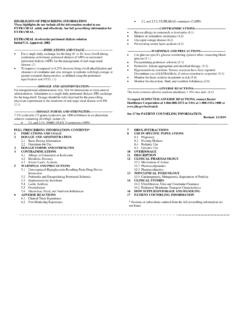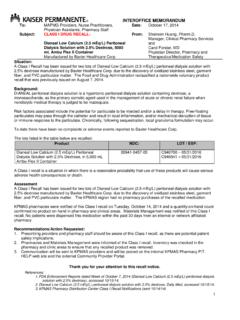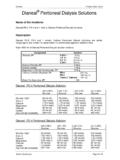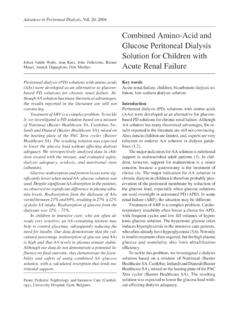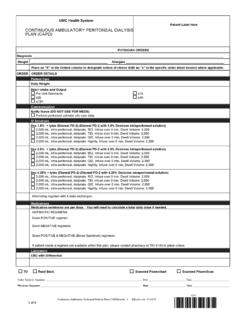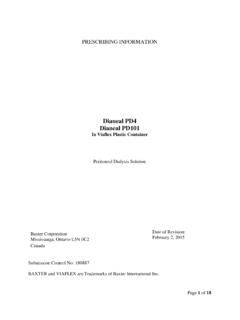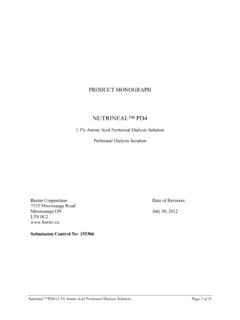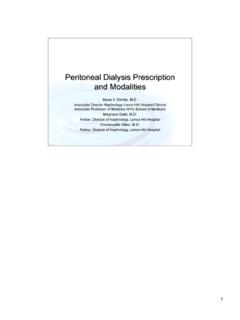Transcription of HIGHLIGHTS OF PRESCRIBING INFORMATION ...
1 HIGHLIGHTS OF PRESCRIBING INFORMATIONT hese HIGHLIGHTS do not include all the INFORMATION needed to use dianeal peritoneal dialysis solutionssafely and effectively. See full PRESCRIBING INFORMATION for dianeal solutionsDIANEAL (dextrose) peritoneal dialysis solutionInitial Approval: 1981 dianeal PD-2 (dextrose) peritoneal dialysis solutionInitial Approval: 1992 dianeal LOW CALCIUM (dextrose) peritonealdialysis solutionInitial Approval: 1992----------------------------INDICATI ONS AND USAGE---------------------------For management of acute or chronic renal AND ADMINISTRATION---------------------For intraperitoneal administration only.(2)---------------------DOSAGE FORMS AND STRENGTHS---------------------- dianeal solutions areavailable in multiple combinations of ingredients and in composition, calculated osmolarity, pH, and ionic concentrations. See full PRESCRIBING INFORMATION for detailed descriptions of each formulation.
2 (3)-------------------------------CONTRA INDICATIONS----------------------------- - Pre-existing severe lactic acidosis (4)-----------------------WARNINGS AND PRECAUTIONS------------------------ Encapsulating peritoneal sclerosis ( ) Peritonitis: Initiate appropriate antimicrobial therapy ( ) Monitor for lactic acidosis in patients at risk ( ) Monitor for electrolyte, fluid, and nutrition imbalances ( )To report SUSPECTED ADVERSE REACTIONS, contact Baxter Healthcare Corporation at 1-866-888-2472 or FDA at 1-800-FDA-1088 or 17 for PATIENT COUNSELING INFORMATIONR evised: [03/2018]FULL PRESCRIBING INFORMATION : CONTENTS*1 INDICATIONS AND USAGE2 DOSAGE AND Dosing for Use3 DOSAGE FORMS AND STRENGTHS4 CONTRAINDICATIONS5 WARNINGS AND and Encapsulating peritoneal Acidosis , Fluid, and Nutrition Imbalances Trials Experience7 DRUG INTERACTIONS8 USE IN SPECIFIC Use10 OVERDOSAGE11 DESCRIPTION12 CLINICAL of SUPPLIED/STORAGE AND HANDLING17 PATIENT COUNSELING INFORMATION *Sections or subsections omitted from the Full PrescribingInformation are not PRESCRIBING INFORMATION1 INDICATIONS AND USAGEDIANEAL peritoneal dialysis solutions are indicated for patients in acute or chronic renal DOSAGE AND Basic Dosing InformationDIANEAL peritoneal dialysis solutions are intended for intraperitoneal administration only.
3 Not for intravenous of therapy, frequency of treatment, formulation, fill volume, duration of dwell, and length of dialysis based on the patient s clinical condition, fluid, electrolyte and specific fill volume depends on body size, usually from to liters per dialysis solutionsare intended for use in Continuous Ambulatory peritoneal dialysis (CAPD)or Automated peritoneal dialysis (APD). Refer to directions accompanying ancillary equipment for CAPD and APD system SelectionTo avoid the risk of severe dehydration and hypovolemia and to minimize the loss of protein, it is advisable to select the peritoneal dialysis solution with the lowest level of osmolarity consistent with the fluid removal requirements for that exchange. As the patient s body weight becomes closer to the ideal dry weight, lowering the dextrose concentration of dianeal solutionis recommended. dianeal dextrose-containing solution has the highest osmolarity of the dianeal solutions and using it for all exchanges may cause dehydration [see Dosage Forms and Strengths (3)].
4 Adding MedicationsIf the resealable rubber plug on the medication port is missing or partly removed, do not use the product if medication is to be add a medication:1. Put on mask. Clean and/or disinfect Prepare medication port site using aseptic Using a syringe with a 1-inch long, 25- to 19-gauge needle, puncture the medication port and inject Reposition container with container ports up and evacuate medication port by squeezing and tapping Mix solution and additive Directions for UseWarmingDIANEAL peritoneal dialysis solutioncan be warmed to 37 C ( F). Only dry heat should be used. For CAPD, it is best to warm solutions within the overwrap using a heating pad. Do not immerse dianeal solutions in water for warming. Do not use a microwave oven to warm OpenTo open, tear the overwrap down at the slit and remove the solution container. Do not use sharp objects to remove the Inspection3 Parenteral drug products should be inspected visually for particulate matter and discoloration prior to administration.
5 Do not use solutions that are cloudy, discolored, contain visible particulate matter, or show evidence of opacity of the plastic, due to moisture absorption during the sterilization process, may be observed. This does not affect the solution quality or safety and may often leave a slight amount of moisture within the overwrap. The opacity should diminish the bag connector to ensure the tip protector (pull ringor blue pull tip) is attached. Do not use if the tip protector is not attached to the connector. Inspectthe dianeal solutioncontainer for signs of leakage and check for minute leaks by squeezing the container firmly. If the container has frangible(s), inspect that they are positioned correctly and are not broken. Do not use dianeal solutionif the frangible(s) are broken or leaks are suspectedas sterility may be dianeal solutionsin ULTRABAG containers, inspect the tubing and drain container for presence of solution.
6 Small droplets are acceptable, but if solution flows past the frangible prior to use, do not use and discard the therapy using ULTRABAG containersSelect appropriate formulation from Table on mask. Clean and/or disinfect hands. Using aseptic technique;1. Uncoil tubing and drain bag, ensuring that the transfer set is closed. 2. Break the connector (Y-set) Remove the tip protector from connector of solution container. Do not reuse the solution or container once the tip protector is Immediately attach the solution container to patient connector (transfer set). 5. Clamp solution line and then break frangible near solution bag. Hang solution container and place the drainage container below the level of the Open transfer set to drain the solution from abdomen. If drainage cannot be established, contact your clinician. When drainage complete, close transfer Remove clamp from solution line and flush new solution to flow into the drainage container for 5 seconds to prime the line.
7 Clamp drain line after flush Open transfer set to fill. When fill complete, close transfer Disconnect ULTRABAG containerfrom transfer set and apply MINICAP disconnect Upon completion of therapy, discard any unused therapy using AMBU-FLEX containers with pull rings or plastic containers with blue pull tipsor pull ringsSelect appropriate formulation from Table 1, 2 or on mask. Clean and/or disinfect hands. Using aseptic technique;1. Remove the tip protector from connector of solution container. Do not reuse the solution or container once the tip protector is Immediately attach the solution container toan appropriate automated peritoneal dialysis set. 3. Continue therapy as instructed in user manual or directions accompanying tubing sets for automated peritoneal dialysis . 4. Upon completion of therapy, discard any unused DOSAGE FORMS AND STRENGTHSDIANEAL peritoneal dialysis solutionis formulated with the following ionic concentrations.
8 Table 1 - dianeal PD-2 and Low Calcium peritoneal dialysis SolutionULTRABAG Containerfor CAPD therapyAMBU-FLEX Containerwith pull ring for APD therapyOSMOLARITY (mOsmol/L) (calc)pHIonic Concentration (mEq/L)SodiumCalciumMagnesiumChlorideLac tateDIANEAL PD-2 ( to ) PD-2 ( to ) PD-2 ( to ) Low Calcium ( mEq/L) ( to ) Low Calcium ( mEq/L) ( to ) LowCalcium ( mEq/L) ( to ) 2 - dianeal Low Calcium peritoneal dialysis Solution Plastic container with blue pull tip for APD therapyOSMOLARITY (mOsmol/L) (calc)pHIonic Concentration (mEq/L)SodiumCalciumMagnesiumChlorideLac tateDIANEAL Low Calcium ( mEq/L) to Low Calcium ( mEq/L) to Low Calcium ( mEq/L) to 3 - dianeal Low Calcium peritoneal dialysis Solution Plastic container with pull ringfor APD therapyOSMOLARITY (mOsmol/L) (calc)pHIonic Concentration (mEq/L)SodiumCalciumMagnesiumChlorideLac tateDIANEAL Low Calcium ( mEq/L) to Low Calcium ( mEq/L) to dialysis solutions are contraindicated in patients with severe lactic acidosis.
9 5 WARNINGS AND Peritonitis and Encapsulating peritoneal SclerosisPeritonitis has been associated with dianeal peritoneal dialysis solution use. Following use, inspect the drained fluid for the presence of fibrin or cloudiness, which may indicate the presence of peritonitis. Improper clamping or priming sequence may result in infusion of air into the peritoneal cavity, which may result in abdominal pain and/or peritonitis. If peritonitis occurs, treat with appropriate peritoneal Sclerosis (EPS), sometimes fatal, is a complication of peritoneal dialysis therapy and has been reported in patients using Lactic AcidosisMonitor patients with conditions known to increase the risk of lactic acidosis [ , severe hypotension or sepsis that can be associated with acute renal failure, hepatic failure, inborn errors of metabolism, and treatment with drugs such as nucleoside/nucleotide reverse transcriptase inhibitors (NRTIs)] before the start of treatment and during 6treatment with lactate-based peritoneal dialysis of dianeal solutionsin patients with severe lactic acidosis is contraindicated [see Contraindications (4)].
10 OverinfusionOverinfusion of peritoneal dialysis solution volume into the peritoneal cavity may be characterized by abdominal distention, feeling of fullness and/or shortness of breath. Drain the peritoneal dialysis solution from the peritoneal cavity to treat Electrolyte, Fluid, and Nutrition ImbalancesPeritoneal dialysis may affect a patient s protein, water-soluble vitamin, potassium, bicarbonate, calcium, and magnesium levels and volume status. Monitor hematology, electrolytes, blood chemistryand fluid statusperiodically and take appropriate clinical is omitted from dianeal solutions because dialysis may be performed to correct hyperkalemia. In situations where there is a normal serum potassium level or hypokalemia, addition of potassium chloride (up to a concentration of 4 mEq/L) to the solution may be necessary to prevent severe hypokalemia. Monitor fluid status to avoid hyper- or hypovolemia and potentially severe consequences including congestive heart failure, volume depletion and hypovolemic shock.
